Yellowstone Supervolcano
World volcano Profiles >North America >Yellowstone
 The Yellowstone volcano lies within Yellowstone National Park, it is an enormous caldera supervolcano which last erupted 600,000 years ago. Old Faithful Geyser regularly shoots boiling water 100s ft into the air in the extensive hydrothermal field.
The Yellowstone volcano lies within Yellowstone National Park, it is an enormous caldera supervolcano which last erupted 600,000 years ago. Old Faithful Geyser regularly shoots boiling water 100s ft into the air in the extensive hydrothermal field.
Yellowstone National park was created in 1872 and covers 8987km 2 or 3472 sq miles mostly within Wyoming but some of it extends into Montana and Idaho. It is famous as the location of Old Faithful Geysir and the basis for Jellystone, home of Yogi bear and BooBoo. People arrivng in Yellowstone often ask where the volcano is- the answer is you are in it!
National Park video Yellowstone
The Geology Bit
It is hard to imagine a volcano this big; for Yellowstone is a supervolcano caused by a Hot spot or mantle plume underneath the American continent. Most continental crust is 20 to 30 miles thick, here it is just 2 caused by the rising of a plume of hot mantle underneath the crust. As the North American plate has moved over the Hot spot it has punched holes through the continental crust. Unlike Hawaii the crust here allows sporadic violent eruptions 100,000s years apart althpugh some quieter eruption so flava have occured.
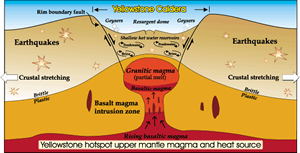 The volcano has had 3 major eruptions in the past 2 miilion years and averages an eruption every 600,000 years or so. The last eruption around 660 000 years ago devastated 1000 sq miles and ejected 240 cubic miles of material. The caldera from this eruption is 85km by 45 km and is 1km deep - in fact so big you don't know you are in it! The caldera was gradually filled in after the last eruption by rhyolite lava flows which only stopped 75,000 years ago.
The volcano has had 3 major eruptions in the past 2 miilion years and averages an eruption every 600,000 years or so. The last eruption around 660 000 years ago devastated 1000 sq miles and ejected 240 cubic miles of material. The caldera from this eruption is 85km by 45 km and is 1km deep - in fact so big you don't know you are in it! The caldera was gradually filled in after the last eruption by rhyolite lava flows which only stopped 75,000 years ago.
Eruptions usually occur when there is rapid and explosive evacuation of magma from fissures around the inner rim of the caldera. The caldera collapses as the magma chamber is evacuated. Within the magma chamber there will be melts of basalt and rhyolite and both of these will be erupted at the same time. The lighter rhyolite magmas will be nearer the top of the magma chamber and the basaltic melts lower down, these are nearer to the original make up of the mantle plume. The rhyolite is high in silica minerals such as quartz and is the lava equivalent of granite. Eventually basaltic melt only is ejected. This first phase of the eruption would be very violent with explosions and lava fountains all around the rim of the caldera.
 Although there have been no recent eruptions of magma the caldera floor was uplifted by about 1m between 1923 and 1984 but has since subsided. frequent earthquakes can distub the delicate plumbing of the hydrothermal areas turning them off and on. There are up to 3000 earthquakes a year in Yellowstone most of which are very small but larger ones have occured in 1959 and 1975.
Yellowstone activity is closely monitored by the Yellowstone volcanic observatory, USGS (United States Geological Survey) and the University of Utah. There are no imminent signs of an eruption at Yellowstone in the next few centuries.
Although there have been no recent eruptions of magma the caldera floor was uplifted by about 1m between 1923 and 1984 but has since subsided. frequent earthquakes can distub the delicate plumbing of the hydrothermal areas turning them off and on. There are up to 3000 earthquakes a year in Yellowstone most of which are very small but larger ones have occured in 1959 and 1975.
Yellowstone activity is closely monitored by the Yellowstone volcanic observatory, USGS (United States Geological Survey) and the University of Utah. There are no imminent signs of an eruption at Yellowstone in the next few centuries.
Yellowstone National Park Website
Yellowstone Caldera : Wikipedea
Snake river plane: Hotspot movement
What to see and How to see it?
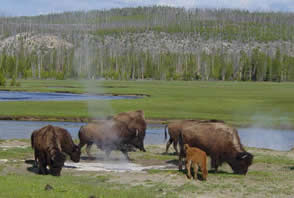 Yellowstone is one of the most visited National Parks in North America and in the summer can attract 30,000 visitors a day.This can lead to traffic jams particularly if some wildlife is spotted.Roads are closed from October to May due to snowfall and accomodation within the park is available generally from May until the Autumn.
Yellowstone is one of the most visited National Parks in North America and in the summer can attract 30,000 visitors a day.This can lead to traffic jams particularly if some wildlife is spotted.Roads are closed from October to May due to snowfall and accomodation within the park is available generally from May until the Autumn.
There are 5 main entrances to the park from the North,North East,West, East and South. The southern entrance links you to Grand Teton National park near Jackson Hole.The most popular route around the park is the 142 mile Grand loop road which takes in all the main sights. There are 10,000 Geothermal features including 250 Geysers and the smell of sulphur and steam will become very familiar.
There are 1200km of hiking trails,600km of paved roads and 5 visitor centres located in the 5 village areas all of which have visitor amenities and facilities. Yellowstone is also renown for its wildlife including herds of roaming buffallo and bears (not herds!)
With so many Geysers in one place I have only mentioned the highlights but you can of course visit all 250 if you want to. Features are sign posted and car parking provided for most sights. The Yellowstone National Park map you gained when you entered the park will help. $25 /car or vehicle.
Upper Geyser Basin
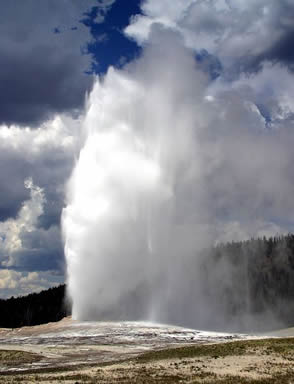 The Upper Geyser basin is home to a quarter of the worlds geysers including Old Faithful. There are lots of well marked paved paths and trails and the terrain is fairly flat, with good wheelchair access. There are plenty of visitor facilities; food, accomodation,visitor centre,petrol station,post office, toilets. It can have the feel of a man made set but the phenomena here are for real not Hollywood magic.
The Upper Geyser basin is home to a quarter of the worlds geysers including Old Faithful. There are lots of well marked paved paths and trails and the terrain is fairly flat, with good wheelchair access. There are plenty of visitor facilities; food, accomodation,visitor centre,petrol station,post office, toilets. It can have the feel of a man made set but the phenomena here are for real not Hollywood magic.
A three mile loop trail to the Morning Glory pool and back along the banks of the fire hole river will take in most of the Geothermal features in the Upper Geyser basin.The route is either along a paved trail suitable for bicycles and wheelchairs or along a boardwalk (no bikes). You can go around clockwise or anticlockwise.
The main attraction is Old Faithful , although it is not the largest or most regular it is predictable at around every 76 minutes. A semi-circular bank of benches lets you wait in comfort for the next eruption. Eruption times are posted so you know when to turn up. Each event lasts 1.5 to 5 minutes and ejects up to 8400 gallons of boiling water up to 55m.
National Park Old Faithful WebcamNational Park Video Guide to Old Faithful
Yellowstone National Park Website
Lower Geyser Basin
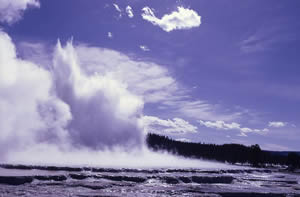 Nearest to the west entrance,on the Grand Loop road , the Lower Geyser basin follows the course of the Firehole river.
Nearest to the west entrance,on the Grand Loop road , the Lower Geyser basin follows the course of the Firehole river.
Fountain Flat drive is a one way road which gives you access to the superheated Ojo Caliente Spring and the Pocket Basin with the parks largest number of boiling mud pots. Imperial Geyser is dormant at present but has a beautiful pool and Spray Geyser is nearby with reliable eruptions which shoot out at a 70 degree angle.
The Fountain paint pots are worth seeing as our the Fountain Geyser( Dormant) , Clepsydra Geyser and the Jelly Geyser and Celestine pool. Stay on the Board walk provided as the crust can be thin and the ground conceal boiling hot mud and water.
Back on the Grand Loop road Great Fountain Geyser is a highlight and has an interval between eruptions of 8-12 hours before it shoots jets 30m high into th air for 45 minutes. Rough timings are available from the Madison Information centre.It is on Firehole lake Drive , a loop off the Grand loop road.
Other Geysers
Steady GeyserNarcissuss Geyser
Bead Geyser
Pink Cone Geyser
Midway Geyser Basin
 The Highlight of Midway geyser basin is the Grand Prismatic Spring which is the largest hot spring in Yellowstone. The 75m by 115m pool is a beautiful blue with multi coloured algae around the edges. The nearby Excelsior Geyser last erupted in the 1880s but now churns out 4000 gallons of hot water/minute.
The Highlight of Midway geyser basin is the Grand Prismatic Spring which is the largest hot spring in Yellowstone. The 75m by 115m pool is a beautiful blue with multi coloured algae around the edges. The nearby Excelsior Geyser last erupted in the 1880s but now churns out 4000 gallons of hot water/minute.
Biscuit Geysir Basin
There are trails to the east and west of the car park and some small reliable Geysers.
Jewel GeyserRusty Geyser
East Mustard Spring
Avoca Spring
Black Sand Basin
Just near the Old Faithful turn is Black Sand basin so called after the Obsidian sand on the ground.Its worth taking a look at Emerald Pool and the reliable Spouter Geyser before the crowds of Old Faithful. You can walk or cycle to Old Faithful from here - about 4 miles.
Other Highlights
Old Faithful Area
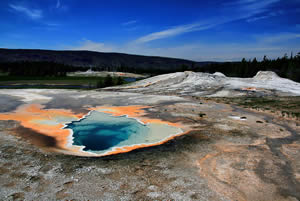 Anemone Geyser: shows stages of an eruption. pools fills and overflows, large bubbles rise to the surface and then water explodes in a column up to 10ft (3m). Small but reliable every 7-10 minutes.
Anemone Geyser: shows stages of an eruption. pools fills and overflows, large bubbles rise to the surface and then water explodes in a column up to 10ft (3m). Small but reliable every 7-10 minutes.
Doublet pool: Deep blue pool with ornate edges. Photographers love it.
Castle Grand Group
Castle geyser: Erupts every 10-12 hours for 20 minutes up to 90ft ( 27m)
Crested Pool: Very hot and costantly boiling sometimes up to 2m. No Algae as too hot.
Grand Geyser: Every 7-15 hours.Several powerful bursts which can reach 200ft( 60m) and last s up to 12 minutes.
Beauty Pool: Blue pool framed by rainbow of bacteria.
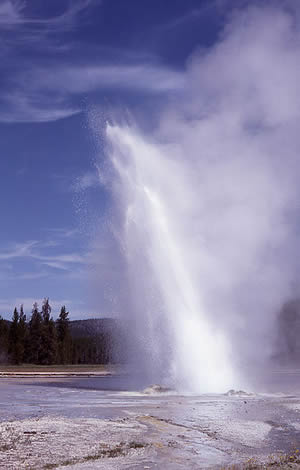 Giant-Grotto Group
Giant-Grotto Group
Giant Geyser: You,ll be lucky to see this one it erupts every 3-10 days but if you catch it you'll see water jets up to 250ft (55-76m) and the display lasting around hour. Not called Giant for nothing. Grotto: Every 8 hours. Not very tall eruption but it can go on for 10 hours up to 10ft.
Daisy Group
Daisy Geyser: Every 90-115minutes the Daisy geyser erupts to a height of 75ft(23m) for 3-5minutes at an angle.
Riverside Morning Group
Riverside Geyser: On eastern bank of the Firehole river this Geyser erupts every 5-6 hours. A 75ft( 23m) column of water arches over the river.
Morning Glory Pool: Looks like the flower its named after but has suffered from vandalism (objects been thrown into the water, blocking the springs vent and reducing the temperature) which has changed the algaes appearance.
Mammoth
Mammoth Hot Springs provided one of the first visitor destinations in Yellowstone. The main attraction is the travertine terraces deposited by calcium carbonate rich waters forming giant steps of white with a pool on each each step.
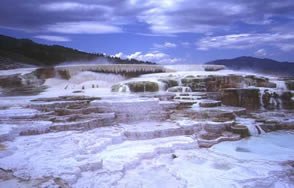 As the water cools Algae grows giving added colour.The Upper terrace is accessible along a loop road whereas the Main terrace is viewed from 2.5 mile boardwalk from the car park.The colourful Minerva Springs is a highlight.
As the water cools Algae grows giving added colour.The Upper terrace is accessible along a loop road whereas the Main terrace is viewed from 2.5 mile boardwalk from the car park.The colourful Minerva Springs is a highlight.
National Park Video guide to Mammoth Hot Springs
Mammoth village provides lots of visitor facilities: Provisions store,Post Office, petrol,food,clinic and the Mammoth Springs Hotel. The Park HQ and the Albright Visitor centre are here.
Canyon
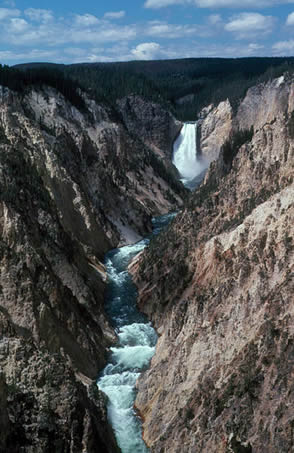 Why is Yellowstone called Yellowstone? At Yellowstone canyon you see exactly why ; the sides of the dramatic Yellowstone canyon are yellow. Hydrothermal fluids have chemically altered the Rhyolite lavas and turned them yellow. The Canyon is 300m deep and has two waterfalls to add to the splendour. Lower falls plunges 94m through the canyon and Upper falls 33m. There are several view points accessible from Canyon village. From the village a one way loop road lets you visit Inspiration Point . You can walk along the Canyon edge trail from here or drive to Grandview point and further on Lookout Point. Above the Lower falls a steep zig zag trail leads to the top of the Lower falls. On the other side of the canyon Uncle Toms trail follows the canyons southern edge to Artists Point or you can drive there.Access to the Upper falls viewpoint is on the Northern side of the canyon 1.5 miles from the village.
Why is Yellowstone called Yellowstone? At Yellowstone canyon you see exactly why ; the sides of the dramatic Yellowstone canyon are yellow. Hydrothermal fluids have chemically altered the Rhyolite lavas and turned them yellow. The Canyon is 300m deep and has two waterfalls to add to the splendour. Lower falls plunges 94m through the canyon and Upper falls 33m. There are several view points accessible from Canyon village. From the village a one way loop road lets you visit Inspiration Point . You can walk along the Canyon edge trail from here or drive to Grandview point and further on Lookout Point. Above the Lower falls a steep zig zag trail leads to the top of the Lower falls. On the other side of the canyon Uncle Toms trail follows the canyons southern edge to Artists Point or you can drive there.Access to the Upper falls viewpoint is on the Northern side of the canyon 1.5 miles from the village.
Canyon Village has lots of tourist facilities: Food, petrol,Post Office,accomodation,Ranger Station and a visitor centre.
Lake
Yellowstone is North Americas largest mountain lake ( 7733ft or 2357m) and measures 20miles by 14 or 32km by 23 and 98m deep (320ft) . The Yellowstone caldera boundary passes through the Lake. The floor of the lake is carefully monitored for changes in shape and a 'bulge' about 2000 feet (600m) long and 100 feet (30m) high has been found suggesting that magma is rising under the lake. North of Fishing bridge the Sour Creek Dome has risen causing the lake bed to rise and tip the Lake water to the southern end of the Lake . Consequently the north shore has newly exposed beaches and in the south tree bases have become submerged . Water exits northwards at Fishing Bridge to flow throught the Yellowstone canyon.
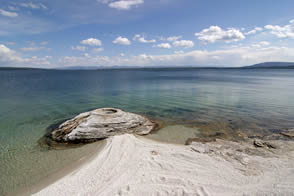
The lake freezes in winter to 1m and is very cold ; swimming is discouraged as hypothermia is a real possibility. Boating is allowed but you will need a permit. There are 3 village areas; Bridge Bay, Lake Village and Fishing Bridge .
Bridge Bay: Ranger Sation, store, slipway.Lake Village: Yellowstone Lake Hotel, Lake Lodge Hospital,Post Office,Store,Ranger Station
Fishing Bridge:Food, store, petrol, RV Park
Links
Yellowstone.net: Information,activities and webcams
Yellowstonepark.com : Information and activities
TravelYellowstone.com : Xanterra are the main providers accomodation in Yellowstone
Yellowstone National Park Website: Fees,camping, information
National Park Videos on areas of the park: clickable map.
Global Volcanism project


